
My memory was as good as ever as Chris Parker and I entered the Grapevine Vintage Railroad parking lot then we started to explore; I first noticed the diesel on the point of our train rather than the steam engine that had been the motive power on my prior visit.
The Grapevine Vintage RailroadThe Grapevine Vintage Railroad (GVRR) is a family-friendly attraction in Grapevine, Texas where guests can travel along the historic Cotton Belt Route on authentic 1920's-era train coaches. The train is in operation for 46 weeks out of the year, to the delight of the thousands of passengers that board the Grapevine Vintage Railroad each year. During the January and first half of February, train rides pause for annual inspections and maintenance. Between March and June, visitors will be able to enjoy train rides every Saturday and Sunday. By the time summer rolls through the depot, trains will run every Friday, Saturday and Sunday during the months of June, July and August.
The route was formerly operated by the Fort Worth and Western Railway and was known as the Tarantula train. In 1999 and for a short period of time, the FWWR contracted with Coe Rail, Inc. for operation of the Tarantula train. An accident with a freight train in 2000 caused the Fort Worth & Western to sever the relationship and took back control of passenger operations. Later that year the City of Grapevine expressed interest to FWWR owner William Davis in owning and operating the Tarantula train. After receiving an offer, the purchase was complete around 2005. The City named their new operation the Grapevine Vintage Railroad and operated the train under trackage agreements with FWWR. When Trinity Metro began operating their TEXRail commuter line, GVRR made arrangements for trackage rights on their right-of-way to Haltom City. From that point on, GVRR uses FWWR trackage under the original agreement.
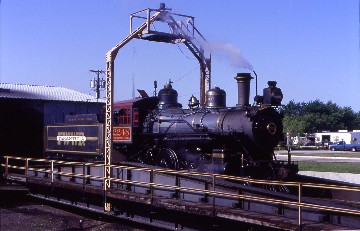
In April 2003, when I tried to ride it, Southern Pacific 4-6-0 2248 was the power. The engine had coupled onto the cars, pulled away but returned to the shop with a steam valve leak and that day's run was cancelled.

Inside this shed is where Southern Pacific 2248 resides.
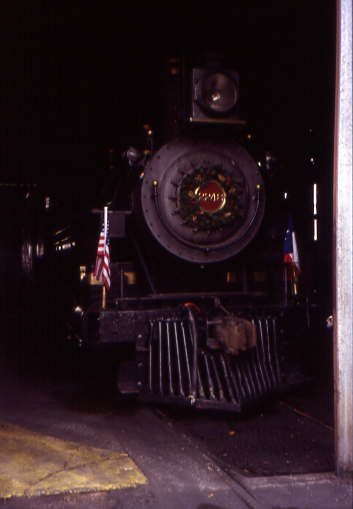
Grapevine Vintage Railroad 4-6-0 2248, ex. Tarantula Railroad 2248, exx. Texas State Railroad 200 1976, exxx. Charles Brown San Fernando, California 1961, exxxx. Purdy Company Los Angeles California 1961, exxxxx. Southern Pacific 2248 1901, nee Southern Pacific 1829 built by Cooke Locomotive in 1896.
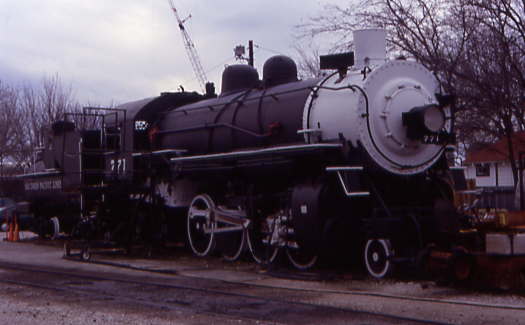

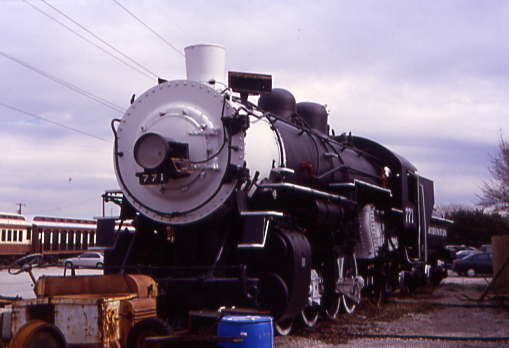
Southern Pacific 4-6-2 771, ex. Texas and New Orleans 771, nee Galveston, Harrisburg and San Antonio Railroad 771, built by Baldwin Locomotive Works in 1913. It was donated to the City of Victoria, Texas in 1955, which sold the locomotive to the Grapevine Vintage Railroad in 2001 for $10.00. It is now on display on Dallas Road and was being worked on in the group's spare time.
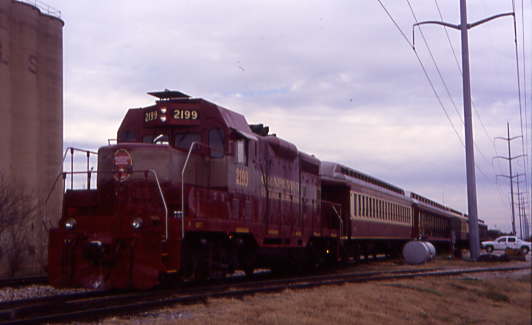
The Grapevine Vintage Train at rest prior to today's excursion to Fort Worth, whose consist was Grapevine Vintage Railroad GP7 2199, Grapevine Vintage Railroad coach 208 "PW McCallum", Grapevine Vintage Railroad coach 1808, "Bob Robertson", Grapevine Vintage Railroad coach 206 "Sue McCafferty", Grapevine Vintage Railroad coach 209, "Mayor Wm. D. Tale" and Grapevine Vintage Railroad coach 1818.
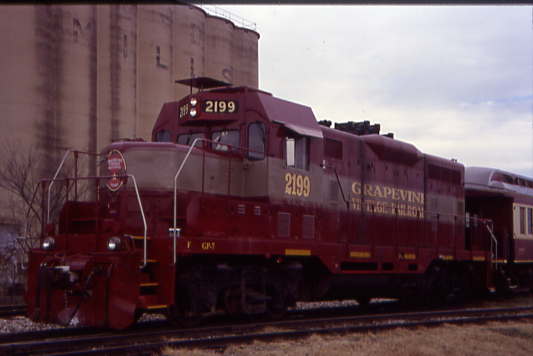
Grapevine Vintage Railroad GP7 2199, nee Santa Fe 2788 built by Electro-Motive Division in 1952.

Grapevine Vintage Railroad coach 208 "PW McCallum", ex. Fort Worth and Western 208, exx. Strasburg Rail Road, exxx. New Jersey Transit 4367, exxxx. Delaware, Lackawanna and Westenn 2367 nee Delaware, Lackawanna and Western 715 built by Pullman Company in 1920. It was converted to "high roof" M.U. trailer in 1930 and rebuilt to a coach-observation car.
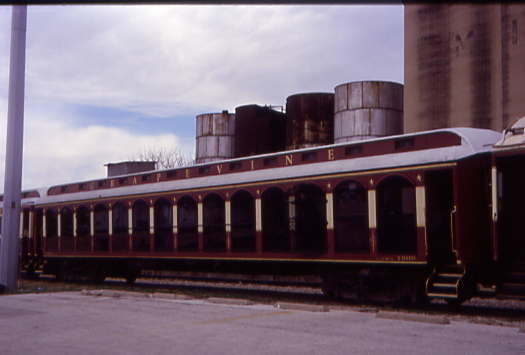
Grapevine Vintage Railroad coach 1808, "Bob Robertson", a heavyweight sightseeing car rebuilt from a coach, history unknown.
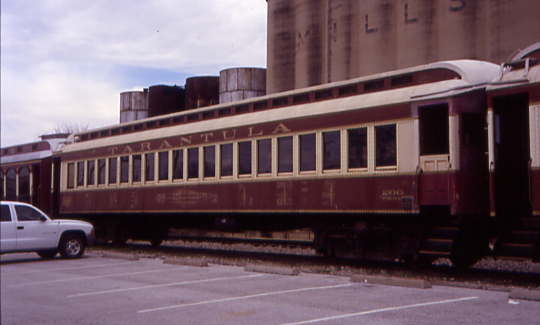
Grapevine Vintage Railroad coach 206 "Sue McCafferty", ex. Forth Worth and Western, exx. Strasburg Rail Road 206, exx. New Jersey Transit 4339, exxx. Erie-Lackwaanna 2339, exxxx. Delaware, Lackawanna and Western 2339, nee Delaware, Lackawanna and Western 687 built by Pullman in 1920. It was converted to "high roof" M.U. trailer in 1930.
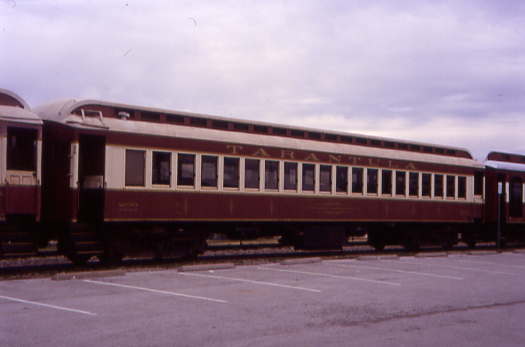
Grapevine Vintage Railroad coach 209, "Mayor Wm. D. Tale", ex. Strasburg Rail Road 209, exx. New Jersey Transit 4355, exxx. Erie-Lackawanna 4335, exxxx. Delaware, Lackawanna and Western 2355, nee Delaware, Lackawanna and Western 703 built by Pullman Company in 1920. It was converted to "high roof" M.U. trailer in 1930.
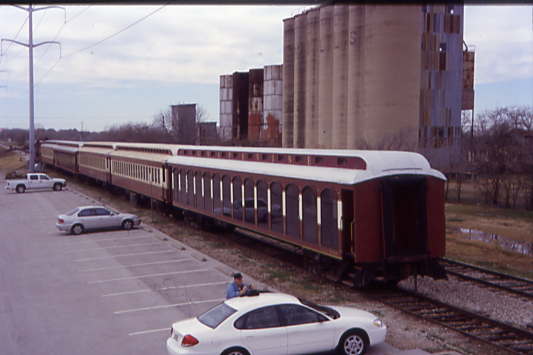
Grapevine Vintage Railroad coach 1818, a heavyweight sightseeing car rebuilt from a coach, history unknown.
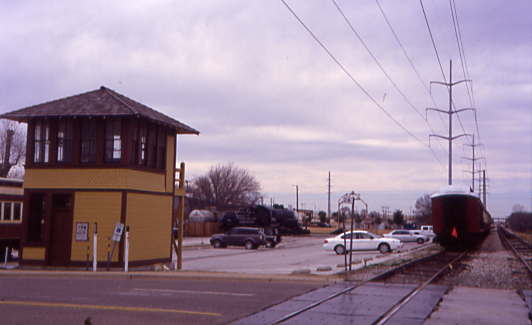
Tower 16 from Sherman, an early settlement in Texas, founded in 1846 for its location near the center of the newly authorized Grayson County. The Houston & Texas Central Railway arrived from the south in 1872 as it continued construction north from Houston through Dallas heading for the Red River fourteen miles north of Sherman. That same year, the Missouri, Kansas & Texas Railroad bridged the Red River and built five miles south to the new town of Denison (named for a Katy vice president), providing rail connections to the Midwest and beyond. This was a boon to the economy of both Denison and Sherman and they grew rapidly. The two railroads worked cooperatively exchanging freight at Denison, and they soon established passenger service connecting Kansas City and St. Louis with Houston and Galveston. By the end of 1883, the H&TC had become controlled by Southern Pacific.
In 1873, the Texas & Pacific Railway built 54 miles east from Sherman to Brookston, the initial segment of an east/west line that was completed into Texarkana in 1876. Sherman was the starting point because construction materials could be shipped on the H&TC from ports in Galveston and Houston. The T&P had obtained a Federal charter from Congress to build a southern transcontinental line between Texarkana and San Diego. A route strategy across Texas had been established years earlier by the Texas Legislature when it authorized railroad charters for the predecessor companies that had been acquired by the T&P. Those charters called for two parallel routes from Texarkana to Fort Worth - a southern route that went south to Marshall and then west to Fort Worth, and a northern route paralleling the Red River to Grayson County that would then turn southwest to Fort Worth. From Fort Worth, a single line would be built to El Paso.
Despite the sizable rail infrastructure in Sherman, only one major interlocker, Tower 16, was ever commissioned, authorized for operation on July 18, 1903. It was located in central Sherman where it protected the crossing of T&P's east/west line and H&TC's north/south line. Tower 16 was a standard SP design and was operated by SP personnel for most of its history. Through the end of 1930, RCT's Annual Reports included a table of active interlockers, and the first to include Tower 16 was dated December 31, 1903. It reported the interlocker as an electrical plant with 35 functions and 31 levers built by the Taylor Signal Company, with the H&TC and T&P listed as the railroads operating through Tower 16. The table published the following year added the Frisco, which continued to be listed until it was omitted from the table dated October 31, 1916. The Frisco was re-included beginning with the table dated December 31, 1923 and the listing remained unchanged through the end of 1930. That 1916-1923 timeframe overlaps with the period during which the Frisco was in receivership, which may have impacted the Frisco's operations at Tower 16.
Tower 16 continued to operate for nearly 100 years, but the rail landscape in the Sherman/Denison area changed significantly over that period. In 1925, Missouri Pacific acquired several Texas railroads and resumed operating in state for the first time since its Katy lease had been dissolved in 1891. By 1930, MP owned a large majority of T&P stock, but did not exercise executive control until 1976 when it acquired the remaining stock and absorbed the T&P's operations. In 1982, Union Pacific acquired MP, allowing MP to continue to operate as a wholly-owned subsidiary. In 1988, UP bought the Katy and merged it into MP. Since MP had also merged the T&P, this gave UP sole ownership of the Joint Track. The Katy's route from Denison to Gainesville and Henrietta had been abandoned west of Whitesboro in 1970, and in 1992, UP abandoned its ex-T&P tracks between Sherman and Whitesboro. Though no longer the Joint Track, it continues to carry significant Denison to Fort Worth traffic for UP.
Tower 16 was relocated to the town of Grapevine near the Cotton Belt depot that serves as the Grapevine Visitor's Center. To relocate the tower, it was sliced horizontally between the floors and moved in two sections. It was reassembled and repainted, and now sits in a parking lot adjacent to the tracks at 709 South Main Street

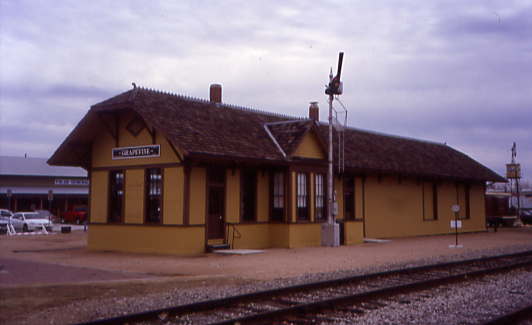
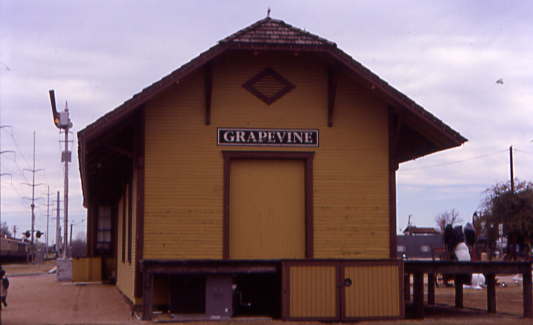
Across the highway was the former St. Louis-Southwestern Grapevine station built in 1901 and was in opertion until 1972 when the station was closed. Through the efforts of the Grapevine Garden Club, the Depot was saved from demolition and moved to Heritage Park at Ball and Wall Streets, where it remained for 20 years. In 1972, the Grapevine Historical Society was organized to utilize the Depot building for a new museum to preserve Grapevine's unique history and heritage. Twenty years later, the Depot and the Grapevine Historical Museum moved back to Main Street near the railroad tracks on land that is now called the Heritage Center. The Depot is the ticketing site of the Grapevine Vintage Railroad.
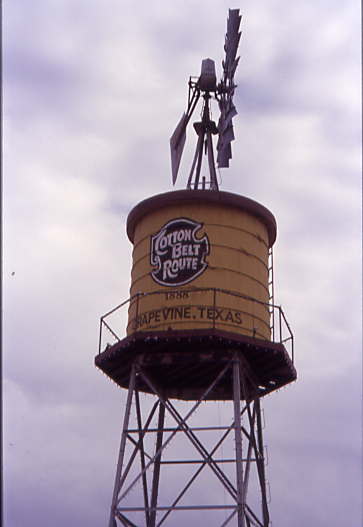
A Cotton Belt symbol on the Grapevine water tower.
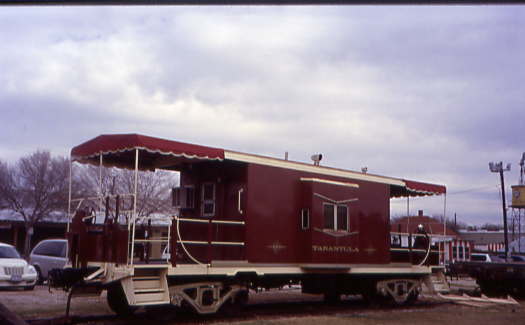
Grapevine Vintage Railroad caboose 1, nee Missouri Pacific 13084 built by the railroad in 1982.
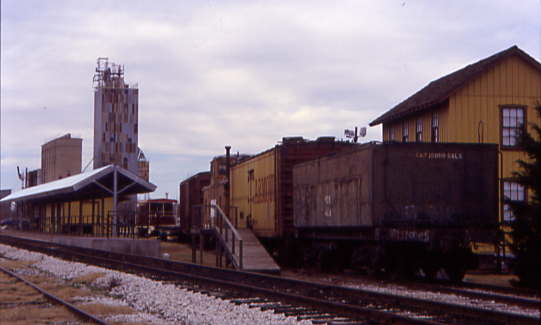
The equipment on display at the Grapevine station.
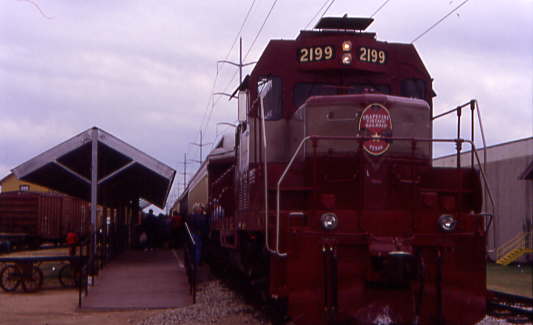
The train then reversed into the station and the passengers boarded; I saved two seats for Chris and I in coach 209 since he was recharging his video camera batteries.
Grapevine to Fort Worth Stockyards 12/30/2006The Cotton Belt Route is a one-and-a-half-hour train ride from the Grapevine Depot on Main Street to the historic Fort Worth Stockyards. This excursion travels along the old Cotton Belt Route through six of Tarrant County's cities and offers views of our beautiful metroplex cityscape and some of our industrial areas.
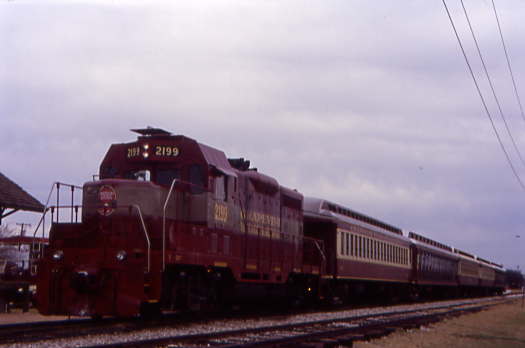
Our train ready to depart, which occurred on time at 1:00 PM and I opened a window to make photography easier.
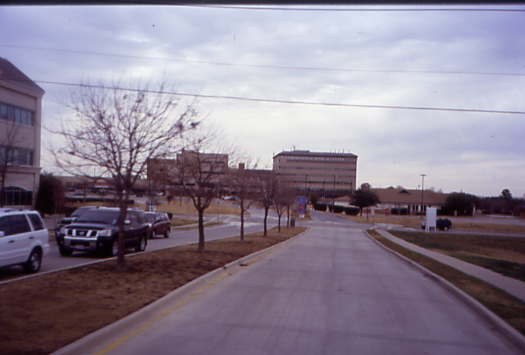
We left the storage area across the street from the Grapevine station and a few minutes later came to a section of track that made our train rock and roll and sway back and forth. After that excitement, we passed the Baylor Medical Center.
The interior of coach 209.
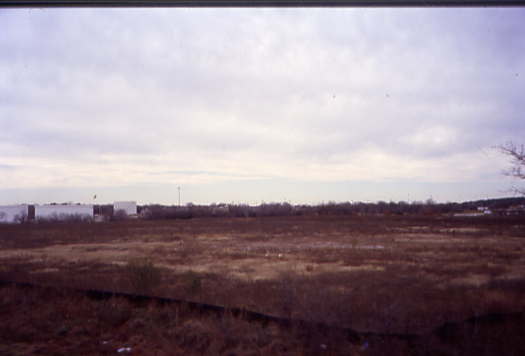
The route to Forth Worth was not all that scenic, as one passed a few remaining open fields and plenty of nice suburban homes, as well as a shopping center with a large Sam's Club and Walmart.
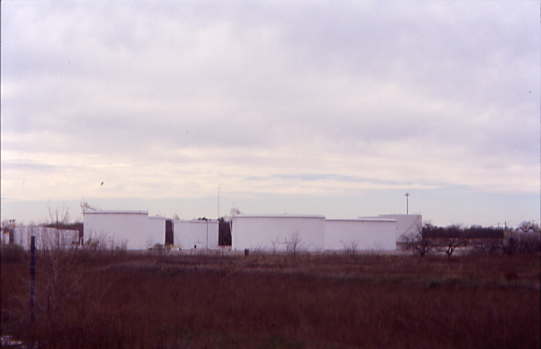
Kock Pipeline Company and tank farm as we passed through Branford.
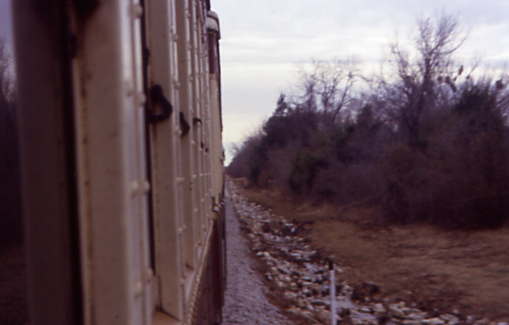
With me sitting next to Chris, I put the camera out of the window for a view along the train, after which we passed the Valero LP tank farm.
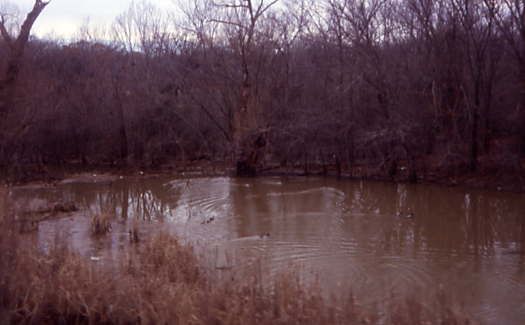
Crossing Little Bear Creek as we entered Hurst and a BNSF caboose on the left.
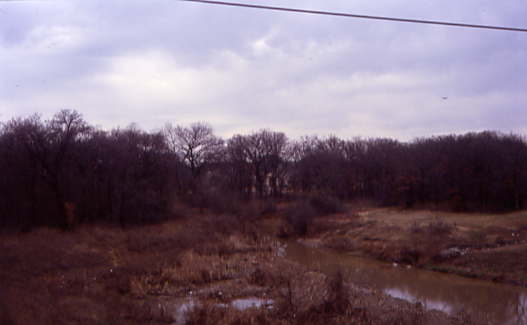
Ducks in a pond on the right side.
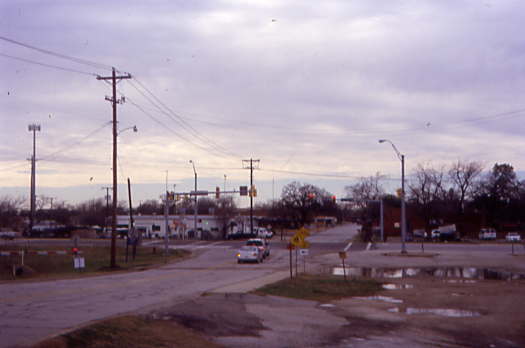
Crossing Precinct Line Road in Hurst.
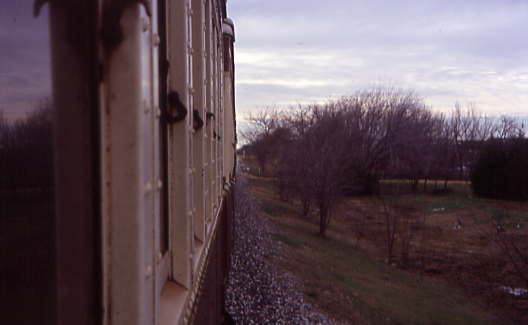
Another view from the outside our train.
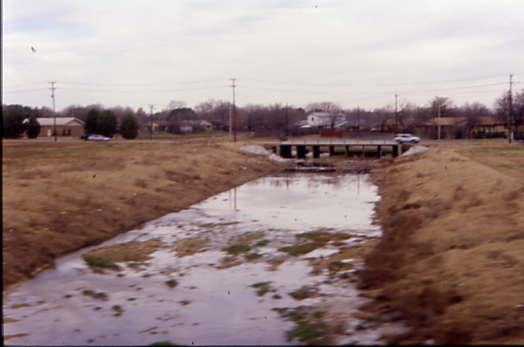
Traversing Calloway Creek as we entered North Richland Hills.
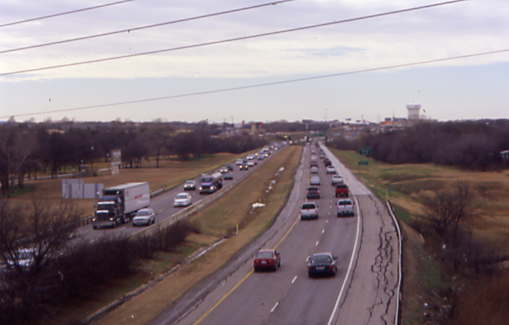
Later we went over Interstate 820 in Haltom City.
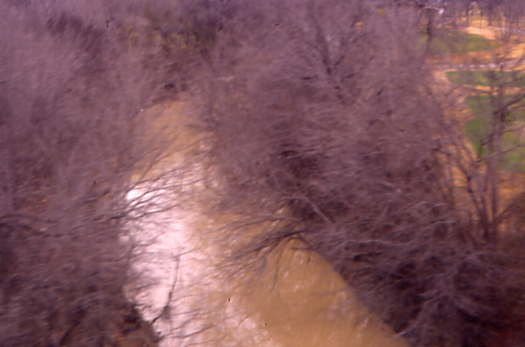
Crossing Big Fossil Creek after we passed the Iron Horse Golf Course as we dropped down the bluff to reach the Trinity River.

We crossed the former Missouri-Kansas-Texas, over which Missouri Pacific once had trackage rights. All this is now under the umbrella of the Union Pacific.
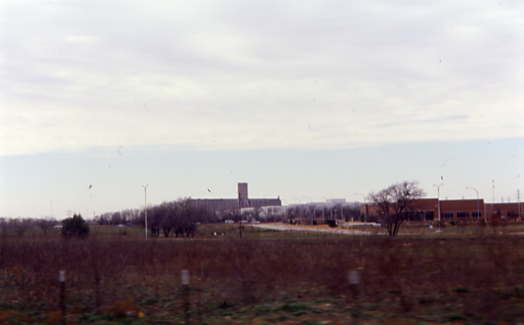

The two large grain elevators at Saginaw.
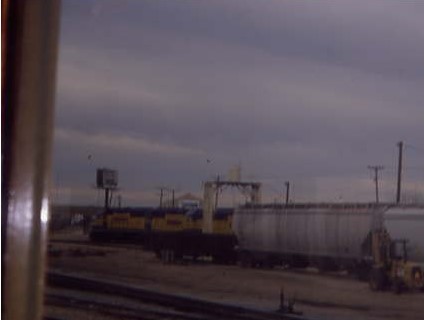
Looking across the car, Fort Worth and Western locomotives were seen as we passed through their yard.
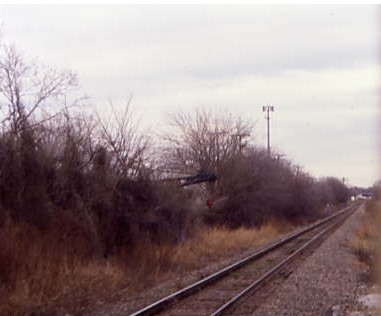
The crossing of the former Rock Island Railroad, now Union Pacific.

The former Fort Worth and Denver crossing, now BNSF.
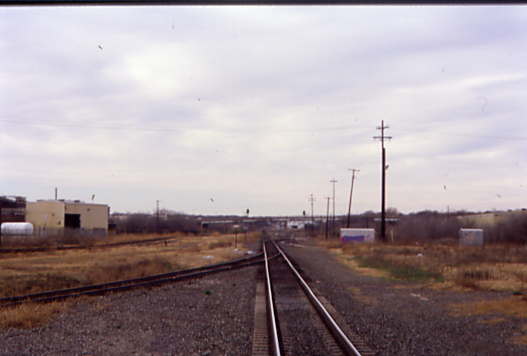
The former Santa Fe crossing, also BNSF.
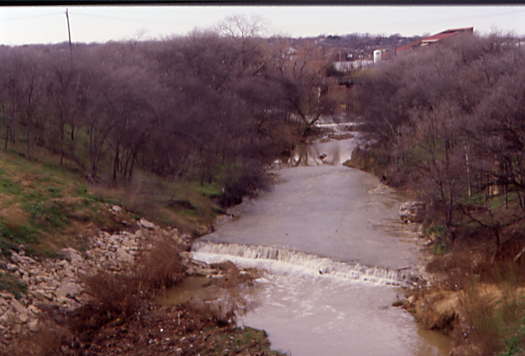
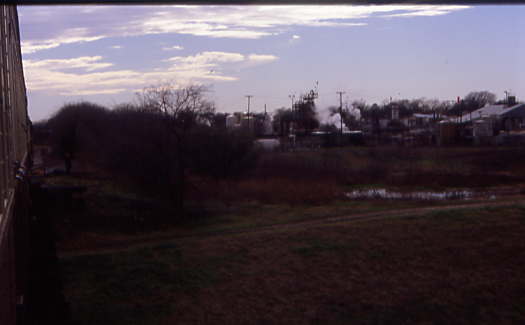
We approached and went across Marine Creek just prior to reaching the wye for the Fort Worth Stockyards.
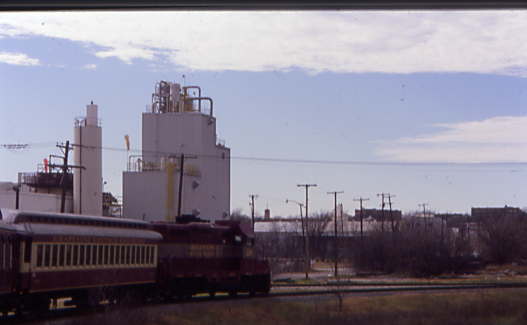

We took the northeast leg of the wye that would take us to the Stockyards station and crossed Marine Creek again.
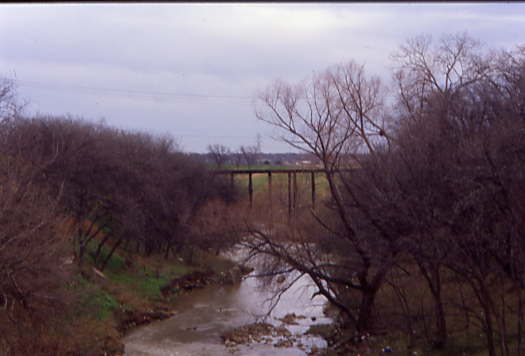
Crossing Marine Creek and a look at the other bridge we had just gone over.

Rounding the last curve into the station with many Stockyards buildings.
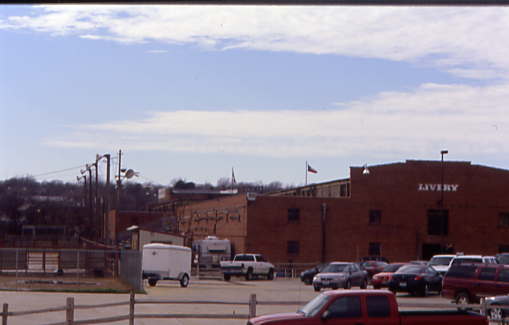
One of the old Stockyard buildings.
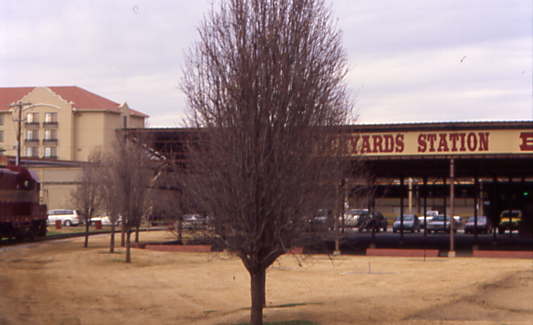
We arrived at the Fort Worth Stockyards station, where I detrained and went to ticket office to pick up my ticket for the train ride along the Trinity River then reached the turntable just after our engine had been turned.
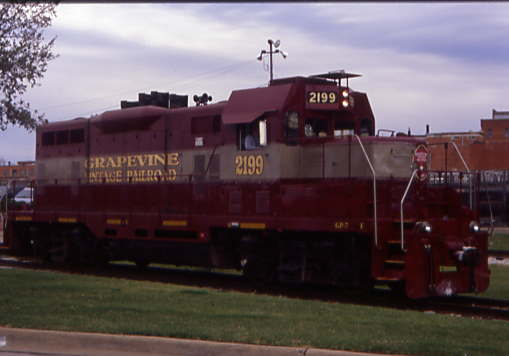
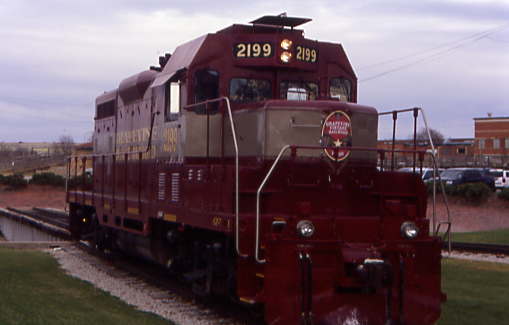
Grapevine Vintage Railroad GP7 2199.

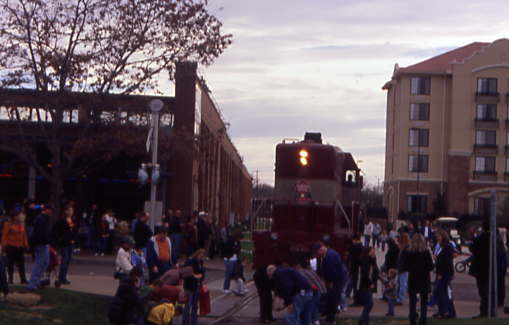
The engine went behind the shops to lay over until needed for the afternoon run west. Chris Parker decided not to ride the other train trip as he wanted time to look around the Stockyards and I decided to explore, but would take the afternoon train ride.
Looking in where the train was after the power had cut off and turned.
The passenger cars inside the station.
The Stockyards Station sign. The arrival of railroads in 1876 made the area a very important livestock center. Fort Worth Union Stockyards opened for business on January 19, 1890, covering 206 acres. On February 7, the Fort Worth Dressed Meat and Packing Company was founded. This facility was operated without profit until purchased by G. W. Simpson of Boston. In an effort to produce revenue, they reached out to the Swift and Armour companies to establish packing houses. By 1886, four stockyards had been built near the railroads.
Boston capitalist Greenleif W. Simpson, with a half dozen Boston and Chicago associates, incorporated the Fort Worth Stock Yards Company on March 23, 1893, and purchased the Union Stock Yards and the Fort Worth Packing Company. The Stockyards experienced early success. By 1907, the Stockyards sold a million cattle per year. The stockyards was an organized place where cattle, sheep, and hogs could be bought, sold and slaughtered. Fort Worth remained an important part of the cattle industry until the 1950's. Business suffered due to livestock auctions held closer to where the livestock were originally produced.
The Fort Worth Stockyards now celebrates Fort Worth's long tradition as a part of the cattle industry and was listed on the National Register as a historical district in 1976. The listing included 46 contributing buildings and one other contributing structure. The Stockyards consist of mainly entertainment and shopping venues that capitalize on the "Cowtown" image of Fort Worth. It is home to the famous boot making company M.L. Leddy's which is located in the heart of the Stockyards and The Maverick Fine Western Wear and Saloon where customers "can 'belly up' to the bar, relax and have a cold beer while in the Stockyards; just like they did in the days of the big cattle drives", as they shop around the store.
A bucking bronco which people could ride.
Cowtown Cattlepen Inc.
Children and adults enjoying the maze.
Someone came to the aid of these children in the maze.
The Armour and Swift packing houses ground signs.
After looking around, I was thirsty and looked for a store which could cure that and ended up at the Sasparilla Saloon-Sandwich & Soda shop where I enjoyed a chocolate malt then shopped for a few minutes. I continued to look around but ended up behind the building where our locomotive was sitting between runs.
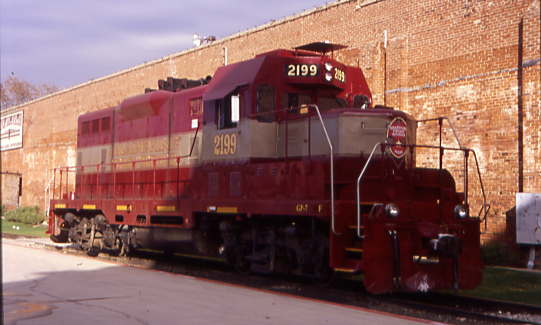
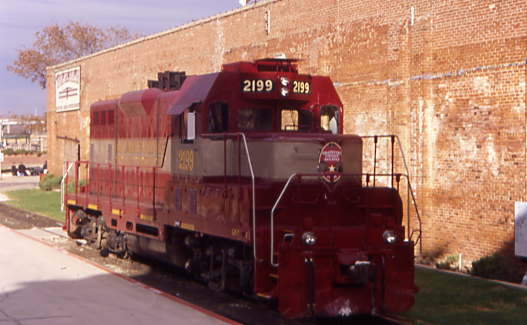
Grapevine Vintage Railroad GP7 2199 during its layover.
Some longhorn cattle in their pens before I went to wait for my next train ride.